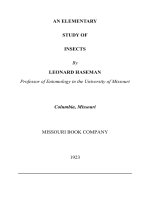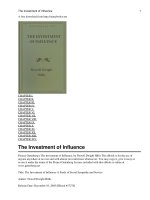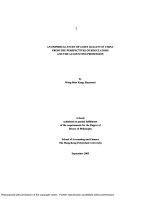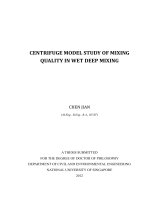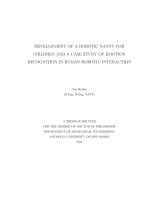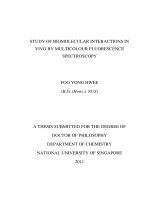An Appraisal Study of Social Attitudes in News Reports towards President Obama’s Visit to Vietnam
Bạn đang xem bản rút gọn của tài liệu. Xem và tải ngay bản đầy đủ của tài liệu tại đây (293.81 KB, 9 trang )
<span class='text_page_counter'>(1)</span><div class='page_container' data-page=1>
21
An Appraisal Study of Social Attitudes in News Reports
towards President Obama’s Visit to Vietnam
Nguyen Thi Thu Hien
*<i>Department of Foreign Languages, Quy Nhon University </i>
<i>170 An Duong Vuong, Quy Nhon, Binh Dinh, Vietnam </i>
Received 01 July 2016
Revised 28 November 2016; Accepted 30 November 2016
<b>Abstract: This study aims at adopting Appraisal Theory to investigate the social attitudes towards </b>
President Obama’s visit to Vietnam in 2016 using news reports interviewing different politicians
as the data. The findings indicate several significances. First, the appraisers of the news tend to
<i>express their own emotions (by Affect) and evaluate Obama’s visit- related entities or events (by </i>
<i>Appreciation) much more than judge the involved people and their behavior (by Judgment). </i>
Besides, the appraisers of the news tend to choose a safe stance either by separating themselves
from the arguments expressing opinions with more Expansions than Contractions or by attributing
the judgmental elements to the external sources. It can be argued that Appraisal Theory can be
applied as a useful tool for Vietnamese language discourse analysis to help uncover various
aspects of sentiment such as the appraisers and objects of appraisal, bias of the appraisers and of
the author, the attitudes and manners of engaging in the sentiment expression.
<i>Keywords: Appraisal Theory, attitude, news reports, expansion, contraction. </i>
<b>1. Introduction</b>
Appraisal Theory is a novel approach to
analyze people’s opinions, appraisals, attitudes,
and emotions toward entities, individuals,
issues, events, topics, and their attributes.
Almost all studies of this field have focused on
the realization of polarity or attitude orientation;
that is, they investigate whether texts reveal a
positive or negative attitude. This theory
describes the types of language used in
communicating emotions and opinions, so it
seems to be able to function as a special
_______
Tel.: 84-983443901
Email:
</div>
<span class='text_page_counter'>(2)</span><div class='page_container' data-page=2>
identify two appraisal resources, namely
Attitude and Engagement. According to this
appraisal framework, the researcher sorts out all
the appraisal groups including the aspects of
appraisers and the objects of appraisal,
classifies types of attitudes to see whether they
are positive or negative, and identifies sources
of attitudes attributed by appraisers. A detailed
introduction of the framework is presented in
the following section.
<b>2. Appraisal theory </b>
Together with the two frameworks of
sentiment analysis proposed by Asher,
Benamara, and Mathieu, [4] and Wiebe,
Wilson, and Cardie [5], Appraisal Theory
developed from Halliday’s Functional
Grammar [6] by Martin and White [7], has
become a useful tool of analysis for those who
want to examine people’s feelings, values and
attitudes via the language they use. White [8]
describes appraisal resources as the language of
sentiment, of arguability and of interpersonal
positioning.
Martin and White [7] have developed the
appraisal analysis framework from their theory,
in which texts would be divided into small
chunks containing evaluation elements called
Appraisal Groups. There are two actors
involved in an appraisal group, namely
appraiser and object of appraisal. These actors
always appear in three major categories of
<b>Appraisal – Attitude, Engagement and </b>
<b>Graduation, the first two of which will be </b>
analyzed in this study because they are the
major resources revealing the appraisers’
attitude meeting the aim of the study. Although
acknowledging that a thorough analysis may be
achieved by using Graduation to identify the
degree of evaluation, we find that it does not
seem to help much to achieve the aim of this
article, so it is not examined.
<b>Focusing on the domain of Attitude, the </b>
<b>article invokes the sub-types of Affect, </b>
<b>Judgment and Appreciation to examine the </b>
different evaluation language resources in news
reports. Attitude is often realized through
adjectival use for feeling happy (Affect), acting
in a silly manner (Judgment), and a lively
performance (Appreciation) [7].
<b>Affect deals with positive and negative </b>
feelings for reacting to behavior, processes, or
phenomena. They are realized as qualities
<i>(adjectives – un/happy), as processes (this </i>
<i>pleases me), as comment adjuncts (un/happily) </i>
<i>or as virtual entities (un/happiness) [9]. </i>
Therefore, analyzing Affect will help
understand the writer’s/ speaker’s feeling
towards the surroundings.
<b>Judgment involves the appraiser evaluating </b>
an intelligent object concerning ethical norms
of society or social norms. For example, in the
<i>appraisal groups “Ông ấy là một nhà độc tài” ( </i>
<i>He is a dictator), or “Sự chân thật của ông ấy </i>
<i>đã thể hiện rõ trong hành vi này” (His sincerity </i>
<i>was evident in this behavior), both “nhà độc </i>
<i>tài” (a dictator) and “ sự chân thật” (his </i>
<i>sincerity) are judgment resources the writer </i>
<i>used to evaluate the Objects of Appraisal “Ông </i>
<i>ấy” (He). </i>
<b>Appreciation is related to the evaluation of </b>
non-intelligent objects. These resources are
widely used in political news reports since
events and policies (both nonintelligent) are
two major objects of appraisal in political news.
Appreciative appraisal involves assessment of
the form, appearance, impact, significance,
quality of human artifacts or natural objects by
reference to aesthetics and other systems of
social values [8].
</div>
<span class='text_page_counter'>(3)</span><div class='page_container' data-page=3>
<b>Contraction closes the alternative voices to </b>
<i>partake in two ways: (1) Proclaim presents </i>
propositions as highly reliable in order to
subdue alternative viewpoints [9]. This can be
<i>done by either emphasizing it using “in fact”, </i>
<i>“of course”, “sure”, etc., or by referring to </i>
evidence (e.g. “the incident shows that…”). (2)
<i>Disclaim is used to reflect or disagree with a </i>
contrary position either by denying using
<i>negations like “not” , “no”, “never” or </i>
<i>countering by using adverbs like “yet”, </i>
<i>however” “although” … , thus explicitly </i>
rejecting alternative viewpoints.
<b>Expansion is classified into Entertain and </b>
Attribute. <i>Entertain </i> invokes alternative
viewpoints; it entails “wordings by which the
authorial voice indicates that its position is but
one of possible positions” (Martin and White
[7]), thus opening up the dialogic space. Such
<i>words as “maybe”, “perhaps”, “probably, “I </i>
<i>think”… entertain alternative arguments by </i>
<i>lowering the strength of proclamation. Attribute </i>
reaches out for alternative positions through
<i>external sources by either acknowledging the </i>
<i>source (e.g. “He argues that…”) or distancing </i>
<i>from it (e.g. “He claims that”). </i>
<b>3. Language resources expressing attitudes </b>
<b>in news reports </b>
After sorted out, the appraisal groups are
analyzed to find out the sub-types of Attitude
resources – <b>Affect, </b> <b>Judgment, </b> and
<b>Appreciation on the positive – negative </b>
polarity scale of feelings, which would help
reveal what attitudes the appraisers have
towards this event. Moreover, Engagement as
sources of evaluation language is also analyzed.
The following table shows a sample
analysis of the appraisal groups.
Table 1. Sample analysis of language resources expressing attitudes in news reports
Appraisal group Appraiser Appraised Attitude +
Polarity
Engagement
<i>Đây là hợp đồng thương mại lớn nhất </i>
<i>giữa hai nước từ trước tới nay </i>
Journalist <i>hợp đồng </i>
<i>thương mại </i>
(commercial
contract)
Appreciation Monogloss
<i>"VN hoan nghênh việc Hoa Kỳ dỡ bỏ </i>
<i>hoàn toàn lệnh cấm bán vũ khí sát </i>
<i>thương cho VN", Chủ tịch nước nhấn </i>
<i>mạnh. </i>
President
Tran Dai
Quang
Việt nam
(Vietnam)
Mental affect Proclaim
Attribute
<i>Tổng thống Barack Obama bày tỏ vui </i>
<i>mừng sang thăm chính thức Việt Nam, </i>
<i>gửi đến nhân dân Việt Nam lời chào hữu </i>
<i>nghị, hợp tác từ nhân dân Hoa Kỳ. </i>
Journalist Tổng thống
Obama
(President
Barack
Obama)
Mental affect Monogloss
<i>Điểm nhấn cuối cùng là sự tiếp đón </i>
<i>nồng nhiệt của người dân Việt Nam </i>
<i>dành cho TT Obama cũng như sự thân </i>
<i>thiện và nhiệt tình của ơng Obama trong </i>
<i>giao lưu với người dân Việt Nam. </i>
Dr. Lê Hồng
Hiệp Người dân VN Ông Obama
<i>(the </i>
<i>Vietnamese </i>
<i>people – Mr. </i>
<i>Obama) </i>
Behavioral
Affect
Behavioral
Affect
Monogloss
</div>
<span class='text_page_counter'>(4)</span><div class='page_container' data-page=4>
<i>xây dựng được một nền tảng chắc </i>
<i>chắn cho mối quan hệ này. </i>
Blinken mối quan hệ
<i>(Foundation of </i>
<i>the </i>
<i>relationship) </i>
<i>Mỹ hồn tồn có thể giúp Việt Nam </i>
<i>nâng cao năng lực kiểm soát biển, </i>
<i>năng lực kiểm ngư, xây dựng luật </i>
<i>pháp. </i>
Dr. Trần Việt
Thái
Mỹ
<i>(The US) </i>
Judgment
(Capability)
Monogloss
The results from this study shows 682
appraisal groups in 20 news reports, each of
which contains an attitudinal resource or/and an
Engagement (coded from G1 to G682). There
are two sub-groups of appraisers: the
Vietnamese appraisers (including President
Tran Dai Quang, Deputy Minister Hà Kim
Ngọc, Major General Lê Văn Cương, the
journalists, Dr. Lê Hồng Hiệp, Dr. Trương
Minh Huy Vũ, and Dr. Trần Việt Thái) and the
American ones (President Obama; Mr. Daniel
Russel, Assistant Secretary of State; Senator
John McCain; Chuck Hagel, ex-Minister of
Defense Ministry; Prof. Carl Thayer; Mr.
Antony Blinken, Deputy Foreign Minister,
Assoc. Prof. Dr. Alexander L. Vuving). The
objects of appraisal are divided into 5 groups,
including Viet Nam (both country and people),
America (both country and people), President
Obama (and his behavior), the policies, and
Vietnam - America relationship.
The appraisal elements in the data can be
either explicit (98.3%) as in G2 or implicit
<b>(approximately at 2%) as in G238 and G458. </b>
<i>G2: Dư luận quan tâm đến chiến lược </i>
<i>“xoay trục” của Mỹ. </i>
<i>G283: Sự kết nối kinh tế của hai bên được </i>
<i>hứa hẹn chuyển động “bằng vận tốc tên lửa” </i>
<i>với chất xúc tác của Hiệp định Đối tác xun </i>
<i>Thái Bình Dương (TPP). </i>
<i>G458: Đó cũng đều là những “bài tốn” </i>
<i>mà chính phủ đang tìm lời giải. </i>
<i>In G283, “Bằng vận tốc tên lửa” ( at a </i>
rocket speed) is an implicit Appreciation
evaluating the speed of development in the
economic relationship of the two countries.
<i>Similarly, “bài toán” (mathematical problems) </i>
is also an implicit Appreciation referring to the
difficulty the Vietnamese Government is facing.
<i>3.1. Social attitudinal preferences for various </i>
<i>objects of appraisal in the data </i>
Because there are 2 subgroups of
appraisers, the Vietnamese and the American,
this section aims at studying what objects of
appraisal are of these two groups of appraisers’
interest.
Table 2. Percentage of Objects of Appraisal
Objects of
appraisal
Appraisers
Viet nam America Mr. Obama Policies Vietnam – America relationship
Vietnamese 8% 13% 21% 35% 39%
American 6% 17% 18% 27% 32%
As Table 2 indicates, the Vietnamese and
the American appraisers seem to share
similarities in choosing various objects of
</div>
<span class='text_page_counter'>(5)</span><div class='page_container' data-page=5>
discussed in the President Obama’s visit. As
can be seen from Table 2, 39% Vietnamese
appraisers and 32% American ones evaluate the
Vietnam- America relationship, showing the
highest percentage. Their second interest is the
policies related to education, economy, and
politics, accounting for 35% and 27%
respectively. While nearly the same number of
the Americans tend to express their evaluation
on both Mr. Obama and their country America
(18% vs. 17%), the Vietnamese appraisers
express a stronger preference for Mr. Obama
than for America (21% compared with only
13%). Vietnam seems to be a less focused
object of appraisal in news reports in question.
From the viewpoints of the Vietnamese and
American appraisers, Vietnam is evaluated by
<i>language resources like tích cực, quan trọng, </i>
<i>thân thiện, hoan nghênh, chào mừng… </i>
<i>(positively, important, friendly, welcome…). </i>
G621: Việt Nam tích cực chuẩn bị phê
chuẩn TPP và cam kết sẽ thực hiện các điều
khoản trong hiệp định. (Appraiser : President
Trần Đại Quang)
<i>G38: Nhưng tôi đến vì VN là một nước </i>
<i>quan trọng trong khu vực và trên thế giới.( </i>
<i>Appraiser : President Obama) </i>
America as an object of appraisal is
<i>evaluated by the positive words like ủng hộ, </i>
<i>mong muốn, muốn, kỳ vọng, hỗ trợ (support, </i>
<i>expect, want, expectation…) </i>
<i>G232: Hoa Kỳ cũng cam kết ủng hộ Việt </i>
<i>Nam tăng cường năng lực về y tế biển đảo. </i>
<i>(Appraiser: Deputy Minister Hà Kim Ngọc) </i>
<i>G167: Hoa Kỳ mong muốn tăng cường </i>
<i>quan hệ với Việt Nam để bảo đảm rằng, khi </i>
<i>Việt Nam phát triển, những người trẻ có nhiều </i>
<i>cơ hội hợp tác với giới trẻ Hoa Kỳ. (Appraiser : </i>
<i>President Obama) </i>
Various language resources are used to
show the viewpoint about President Obama and
his visit like nóng bỏng nhất, lôi cuốn, thu hút,
trông đợi, mong muốn, muốn, quan tâm (most
attractive, attract, expectation, concerning,
interest…)
<i>G287: Tổng thống Obama sang Việt Nam </i>
<i>khi Biển Đông trở thành một trong những vấn </i>
<i>đề nóng bỏng nhất, lơi cuốn sự quan tâm của </i>
<i>cộng đồng quốc tế. (Appraiser: Major general </i>
<i>Lê Văn Cương) </i>
<i>G72: Về những gì ông ấy trông đợi, chắc </i>
<i>chắn đó sẽ là các cuộc gặp với những nhà lãnh </i>
<i>đạo mới của Việt Nam, từ Chủ tịch Nước, Thủ </i>
<i>tướng và Tổng bí thư Nguyễn Phú Trọng, người </i>
<i>mà ông Obama đã tiếp tại Nhà Trắng hồi năm </i>
<i>ngoái. </i>
Another object of appraisal is the policies.
Mainly involving TPP, lifting a decades-long
ban on the sale of military equipment,
education, economy, these policies are
<i>evaluated by such words as nhạy cảm, có ý </i>
<i>nghĩa quan trọng, cân bằng, ổn định, cùng </i>
<i>thắng (sensitive, of important significance, </i>
<i>stable, win-win, balanced) </i>
<i>G120: Đây là vấn đề khá nhạy cảm, </i>
<i>(Appraiser: Major general Lê Văn Cương) </i>
<i>G98: Đây là hiệp định có ý nghĩa quan </i>
<i>trọng đối với khu vực và thế giới. (Appraiser : </i>
<i>Daniel Russell) </i>
Regarding the Vietnam - America
relationship, some major appraisal resources
found in the data are toàn diện, thực chất, nhất
trí, hỗ trợ, ủng hộ (comprehensively, efficiently,
agree, supporting).
<i>G 56: Sự kiện này cho thấy quan hệ Việt - </i>
<i>Mỹ đang phát triển toàn diện và thực chất </i>
<i>(Appraiser: Journalist) </i>
<i>G6: Hoa Kỳ và Việt Nam cũng đã nhất trí </i>
<i>thúc đẩy hợp tác trong các vấn đề khu vực và </i>
<i>quốc tế; hợp tác hạt nhân dân sự, tham gia hoạt </i>
<i>động gìn giữ hịa bình Liên hợp quốc. </i>
<i>(Appraiser : President Obama) </i>
<i>3.1. Social attitudes towards Obama’s visit via </i>
<i>attitudinal resources in the data </i>
All the three types of Attitude, namely
Affect, Judgment and Appreciation appear in
the data at different frequency levels.
</div>
<span class='text_page_counter'>(6)</span><div class='page_container' data-page=6>
Affect (41.7% and 37.3% respectively), and
then Judgment (21%). The appraisers mainly
focus on assessing non-intelligent objects (i.e.
policies and relationships) and show their
emotions at the event and the related activities.
Occasionally, they have also expressed their
judgment on the President, the Vietnamese or
the American government and people. It can be
seen from this result that the focus of the
society about President Obama’s visit is not to
judge people involved and their behavior, but to
show emotions or feelings and to evaluate
entities and events related. However, it is quite
interesting to see that almost all appraisers have
positive appraisals whatever types of resources
they choose. Only 1.9% fall into negative
evaluation.
Table 3. Social attitudes via Attitude systems
in the data
Types of
Attitude
Percentage Positive Negative
Affect 37.3% 37.1% 0.2%
Judgment 21 % 20.6% 0.4%
Appreciation 41.7% 45.4% 1.3%
The most popular attitudinal resource is
Appreciation, making up 41.7%. Almost all
positive evaluations for policies, entities, and
events are often expressed by such words as
<i>“sáng kiến quan trọng nhất”(the most </i>
<i>important initiative) in G156, or “một bước </i>
<i>tiến”(a breakthrough) in G589, or kết thúc </i>
<i>thành công,( a successful ending), or tác động </i>
<i>tích cực (a positive effect). </i>
<i>G156: New York Times thì đánh giá, quyết </i>
<i>định dỡ lệnh cấm vận vũ khí là “sáng kiến quan </i>
<i>trọng nhất” giữa Việt Nam và Mỹ được công bố </i>
<i>trong chuyến thăm của ông Obama tính đến </i>
<i>thời điểm này. </i>
<i>G589: Đối với Việt Nam, TPP là một bước </i>
<i>tiến mà Việt Nam tham gia để hội nhập với </i>
<i>thế giới. </i>
Some negative appraisals can occasionally
<i>be seen in the data like “hạn chế” (limited), or </i>
<i>“chậm” (slow), to evaluate the economic </i>
resources of Vietnam and the progress in the
Vietnam- America relationship.
<i>G 231: Cái khó nhất của Việt Nam là nguồn </i>
<i>lực còn hạn chế </i>
<i>G303: Tuy rằng có hơi chậm một chút </i>
<i><b>nhưng hiệu quả và chắn chắn. </b></i>
Accounting for 37.3%, positive feelings
<i>presented by Affect resources such as trông đợi, </i>
<i>mong muốn, xúc động, nhất trí (expect, desire, </i>
<i>moved, agree) come from the American, the </i>
Vietnamese, President Obama, some others
interviewed (as in G32, G68, and G132).
<i>G 32: Nhưng có một điều tơi rất trông đợi </i>
<i>từ chuyến thăm này, liên quan tới quan hệ giao </i>
<i>lưu nhân dân. </i>
<i>G68: Mỹ muốn chúng ta ngày càng có vai </i>
<i>trị lớn hơn trong ASEAN cũng như trong các tổ </i>
<i>chức khác. </i>
<i>G 132: Tổng thống Obama đã đặt tay lên </i>
<i>trái tim mình và nói: “Tơi thực sự xúc động. </i>
<i>Tình cảm của nhân dân Việt Nam đã lay động </i>
<i>trái tim tôi”. (Obama – Việt nam) </i>
Only 0.2% express negative emotions by
<i>words like những lo ngại, hiểu lầm, nghi kỵ </i>
<i>(some worries, misunderstandings, suspicions) </i>
used to evaluate the Vietnam - America
relationship (eg. G600, and G320)
<i>G600: Hợp tác an ninh được đặt sang một </i>
<i>bên vì mỗi bên vẫn cịn có những lo ngại riêng. </i>
<i>G 320: Vì vậy, việc “nâng cấp” ngay quan hệ </i>
<i>song phương lên mức “đối tác chiến lược” nếu </i>
<i>có xảy ra thì cũng chủ yếu mang tính chất biểu </i>
<i>tượng, và vì vậy có thể khơng cần thiết, nhất là </i>
<i>nếu nó có thể gây ra những hiểu lầm, nghi kỵ từ </i>
<i>một vài quốc gia khác. </i>
Although accounting for only 21% of all
Attitude resources, like Appreciation and
Affect, most of the Judgmental elements are
positively expressed (as in G7 to judge the
activity of Vietnam).
</div>
<span class='text_page_counter'>(7)</span><div class='page_container' data-page=7>
However, a small number of Judgments
<i>express negative evaluation, as “ngần ngại” </i>
<i>(hesitated) in the following example, </i>
<i>G 12: Điều này cịn có tác động đến một bộ </i>
<i>phận nhỏ người Mỹ còn ngần ngại thúc đẩy </i>
<i>quan hệ Việt-Mỹ. </i>
Overall, the attitudinal analysis shows that
the appraisers have very positive feelings,
emotions, evaluations, and judgments towards
President Obama’s visit. Moreover, more
interest has been shown to the policies and the
two countries’ relationship than to the other
three objects of appraisal. This can be seen in
the higher percentage of Appreciation than of
Affect and Judgment.
<i>3.2. Social attitudes towards Obama’s visit via </i>
<i>Engagement in the data </i>
Regarding Engagement, both Monogloss
and Heterogloss appear in the news reports,
ranking 33% and 67% respectively. The
difference in the frequency of these two types
can be discussed as a genre feature. The data
contain news reports which are written as a
result of the interviews made by the journalists;
therefore, most of the evaluation resources are
non - authorial; that is, they come from the
other sources like some politicians or political
experts. As stated by Martin and White [7],
Monogloss expresses the factual information;
accordingly, for the aim of the study –
investigating the social attitudes, only
Heterogloss is discussed in this part.
Table 4. Types of Heterogloss
Types of
Heterogloss
Contraction Expansion
Proclaim Disclaim Entertain Attribute
Percentage 16.5% 21.8% 22.1% 39.6%
Total 38.3% 61.7%
As can be seen from Table 4, the majority
of Heterogloss in the data is Expansion, making
up 61.7%. This figure reveals that the
appraisers are somewhat cautious in
commenting or giving opinions about Obama’s
visit - related activities or events. According to
White [8] and Martin and White [7], when
Expansion is used in a text, the author actually
wants to distance himself from the
responsibility for the information, thereby
opening a dialogic space. In this case, by using
<i>words like “có thể” (can), “có lẽ” (perhaps), </i>
or attributing the evaluation resources to the
other sources in a direct or indirect quotation
<i>like “nói” (said), “cho rằng” (claimed), “theo </i>
<i>tờ New York Times” ( according to the New </i>
<i>York Times), the appraisers can distance </i>
themselves from the responsibility for such
judgmental elements. For example, the word
<i>“có thể” (it can be seen that…) in G345 shows </i>
that the appraiser is cautious when commenting,
thereby inviting the readers/ listeners to join
into the interview.
<i>G345: Có thể thấy từ sau chiến tranh thế </i>
<i>giới thứ hai cho đến nay, suốt 70 năm qua nước </i>
<i>Mỹ trở thành siêu cường,(Entertain) </i>
Similarly, in G210 the journalist has
attributed the comment about Mr. Obama’s visit
to Hagel. However, this use of Hagel’s
comment still reflects the journalist’s stance.
This is because the journalist has substantial
control over his/her choice of content, words
and context, thereby shaping the material to
support his/her argument.
<i>G210: “Tơi biết chắc chắn những hình ảnh </i>
<i>[về chuyến thăm Việt Nam của ông Obama] sẽ </i>
<i>gợi nhớ lại nhiều ký ức”, Hagel nói với New </i>
<i>York Times. (Attribute) </i>
It is possible, therefore, to argue that
attributing sentiment to other people can
convey the journalist’s viewpoint as well.
Another type is Contraction, which
accounts for 38.3% of the whole Heterogloss.
For example,
<i>G52: Dư luận quan tâm đến chiến lược </i>
<i>“xoay trục” của Mỹ, và dĩ nhiên quan hệ </i>
<i>Việt-Mỹ cũng thu hút đáng kể ánh nhìn. (Quang </i>
<i>Thái) (Proclaim) </i>
</div>
<span class='text_page_counter'>(8)</span><div class='page_container' data-page=8>
<i>gợi nhớ lại nhiều ký ức”, Hagel nói với New </i>
<i>York Times. (Proclaim) </i>
<i>G43: Vấn đề cấm vận vũ khí sát thương và </i>
<i>nhân quyền lại bị ràng buộc bởi quan điểm của </i>
<i>người Mỹ. Tuy nhiên, hai bên sẽ nỗ lực thu hẹp </i>
<i>khoảng cách quan điểm về nhân quyền để Tổng </i>
<i>thống Obama có thể dỡ bỏ hoàn toàn lệnh </i>
<i>cấm.</i> <i><b> (Disclaim) </b></i>
When using this appraisal system, the
appraisers either provide evidence for their
<i>comment or emphasize its correctness by “dĩ </i>
<i>nhiên”(certainly) </i> (in G52) or <i>“chắc </i>
<i>chắn”(surely) (in G210), or they can disclaim </i>
the previous information by countering it with
<i>words like “tuy nhiên” (however) (G43), </i>
<i>“nhưng” (but)… By using these language </i>
resources, the appraisers have strengthened
their opinion, thus probably showing a close to
the alternative viewpoints.
<b>4. Conclusion </b>
This article has examined the language of
evaluation in 20 news reports about President
Obama’s visit to Vietnam in 2016 drawing on
the Appraisal framework. This has enabled us
to identify the social attitudes towards this
event via the analysis of Attitude and
Engagement resources. The results show that
the appraisers express different viewpoints
about 5 objects of appraisal, the majority of
which are positive feelings, emotions or
judgments. Moreover, the appraisers tend to
express their own emotions and evaluate
Obama’s visit- related entities or events much
more than judge the people and their behavior.
Regarding Engagement as sources of attitudes,
the findings show that the appraisers tend to
choose a safe stance either by separating
themselves from the arguments expressing
opinions with more Expansions than
Contractions or by attributing the judgmental
elements to the external sources; as a result,
readers of this genre can have access to more
alternative viewpoints.
<b>References </b>
[1] Nguyen, H.T.T., Nghĩa liên nhân của ngôn ngữ
trong thể loại bình luận báo chí tiếng Anh- nhìn từ
Ngữ pháp Chức năng và Thuyết Đánh giá, Tạp chí
Từ điển học và Bách khoa thư, 3(41),(2016) 109.
[2] Tran,V.T.H., A Linguistic Study on Social
Attitude towards the Quality Issues of
Postgraduate Education in Vietnam, Thesis of
Doctor of Philosophy, Department of Education,
University of Wollongong, 2011.
[3] Vo, D.D., Style, Structure and Ideology in English
and Vietnamese Business Hard News Reporting –
A Comparative Study, Thesis of Doctor of
Philosophy in Linguistics, Falcuty of Social
Sciences and Humanities, University of Adelaide,
2011.
[4] Asher, N., Benamara, F. and Mathieu, Y.Y. ,
“Appraisal of Opinion Expressions in Discourse”,
Lingvisticae Investigationes, 32 2 (2009) 279.
[5] Wiebe, J., Wilson, T. and Cardie, C., “Annotating
Expressions of Opinions and Emotions in
Language”, Language Resources and Evaluation,1
2 (2005) 165.
[6] Halliday, M.A.K., An Introduction to Functional
Grammar, London: Edward
[7] Arnold, 1994.
[8] Martin, J.R., & White, P.R.R., The Language of
Evaluation: Appraisal in English, New York:
Palgrave Macmillan, 2005.
[9] White, P.R.R., Subjectivity, Evaluation and Point
of View in Media Discourse. In C.Coffin, A
Hewings & . O’Halloran (Eds), Applying English
Grammar. London: Hodder Arnold, 2005.
[10] White, P.R.R., Appraisal - the Language of
Evaluation and Stance, in Verschueren, J., J.
<i>Östman, J. Blommaert, & C. Bulcaen (eds.) The </i>
</div>
<span class='text_page_counter'>(9)</span><div class='page_container' data-page=9>
Nghiên cứu ngôn ngữ đánh giá thể hiện quan điểm của xã hội
trên các bản tin báo chí về chuyến thăm Việt Nam
của tổng thống Mỹ Obama
Nguyễn Thị Thu Hiền
<i>Khoa Ngoại ngữ, Đại học Quy Nhơn, 170 An Dương Vương, Quy Nhơn, Bình Định, Việt Nam </i>
<b>Tóm tắt: Bài báo này áp dụng khung lý thuyết Đánh giá vào việc nghiên cứu thái độ của xã hội </b>
đối với chuyến thăm Việt Nam của tổng thống Mỹ Obama năm 2016 dựa trên nguồn ngữ liệu là bản
tin báo chí tường thuật các cuộc phỏng vấn các nhà chính trị khác nhau. Kết quả nghiên cứu chỉ ra
rằng chủ thể đánh giá trong bản tin có xu hướng thể hiện cảm xúc của bản thân (thông qua nguồn ngôn
liệu Cảm xúc) và đánh giá những sự kiện liên quan đến chuyến thăm của tổng thống Obama (thông
qua Đánh giá cảm quan) hơn là phán xét những người liên quan và hành vi của họ (thơng qua Phán
xét). Bên cạnh đó, chủ thể đánh giá trong bản tin cũng chọn một vị thế an toàn khi thể hiện quan điểm
bằng cách sử dụng nhiều nguồn Đa thoại khai triển hơn là Đa thoại hạn định hoặc bằng cách gán các
thành tố đánh giá cho một nguồn khác. Bài báo cho thấy rằng Thuyết Đánh giá có thể được áp dụng
trong nghiên cứu diễn ngôn tiếng Việt nhằm giúp bộc lộ các bình diện của thái độ tình cảm như chủ
thể đánh giá, đối tượng đánh giá, quan điểm của chủ thể đánh giá và của tác giả diễn ngôn, và cách
thức tham thoại trong các nguồn ngôn liệu bày tỏ thái độ.
</div>
<!--links-->

